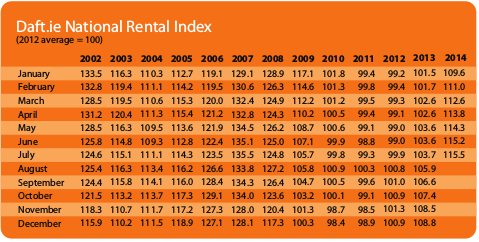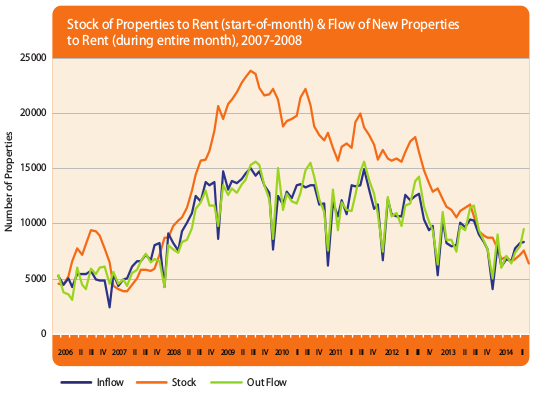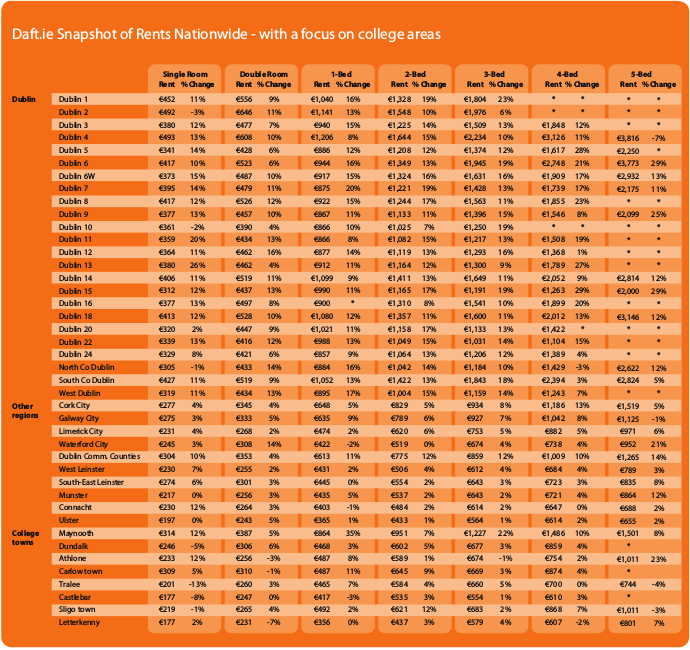Rising rents and lack of properties 'source of alarm' for students
Daft Reports
- Ronan Lyons (House Price, Q1 2024)
- Ronan Lyons (Rental Price, Q4 2023)
- Ronan Lyons (House Price, Q4 2023)
- Ronan Lyons (Rental Price, Q3 2023)
- Ronan Lyons (House Price, Q3 2023)
- Ronan Lyons (Rental Price, Q2 2023)
- Ronan Lyons (House Price, Q2 2023)
- Ronan Lyons (Rental Price, Q1 2023)
- Ronan Lyons (House Price, Q1 2023)
- Ronan Lyons (Rental Price, Q4 2022)
- Ronan Lyons (House Price, Q4 2022)
- Ronan Lyons (Rental Price, Q3 2022)
- Ronan Lyons (House Price, Q3 2022)
- Ronan Lyons (Rental Price, Q2 2022)
- Ronan Lyons (House Price, Q2 2022)
- Ronan Lyons (Rental Price, Q1 2022)
- Ronan Lyons (House Price, Q1 2022)
- Ronan Lyons (Rental, Q4 2021)
- Ronan Lyons (House Price, Q4 2021)
- Ronan Lyons (Rental, Q3 2021)
- Ronan Lyons (House Price, Q3 2021)
- Ronan Lyons (Rental, Q2 2021)
- Ronan Lyons (House Price, Q2 2021)
- Ronan Lyons (Rental, Q1 2021)
- Ronan Lyons (House Price, Q1 2021)
- Ronan Lyons (Rental, Q4 2020)
- Ronan Lyons (House Price, Q4 2020)
- Ronan Lyons (Wealth, H2 2020)
- Ronan Lyons (Rental, Q3 2020)
- Ronan Lyons (House Price, Q3 2020)
- Ronan Lyons (Housing, July 2020)
- Ronan Lyons (Housing, June 2020)
- Ronan Lyons (Housing, May 2020)
- Ronan Lyons (Rental, Q1 2020)
- Ronan Lyons (House Price, Q1 2020)
- Ronan Lyons (Rental, Q4 2019)
- Ronan Lyons (House Price, Q4 2019)
- Ronan Lyons (Wealth, H2 2019)
- Ronan Lyons (Rental, Q3 2019)
- Ronan Lyons (House Price, Q3 2019)
- Pierre Yimbog (Rental, Q2 2019)
- Ronan Lyons (House Price, Q2 2019)
- Ronan Lyons (Wealth, H1 2019)
- Ronan Lyons (Rental, Q1 2019)
- Ronan Lyons (House Price, Q1 2019)
- Ronan Lyons (Rental, Q4 2018)
- Ronan Lyons (House Price, Q4 2018)
- Ronan Lyons (Wealth, H2 2018)
- Ronan Lyons (Rental, Q3 2018)
- Ronan Lyons (House Price, Q3 2018)
- Shane De Rís (Rental, Q2 2018)
- Ronan Lyons (House Price, Q2 2018)
- Ronan Lyons (Wealth, 2018)
- Ronan Lyons (Rental, Q1 2018)
- Ronan Lyons (House Price, Q1 2018)
- Ronan Lyons (Rental, Q4 2017)
- Ronan Lyons (House Price, Q4 2017)
- Ronan Lyons (Rental, Q3 2017)
- Ronan Lyons (House Price, Q3 2017)
- Katie Ascough (Rental, Q2 2017)
- Ronan Lyons (Wealth, 2017)
- Ronan Lyons (House Price, Q2 2017)
- Ronan Lyons (Rental, Q1 2017)
- Ronan Lyons (House Price, Q1 2017)
- Ronan Lyons (Rental, Q4 2016)
- Ronan Lyons (House Price, Q4 2016)
- Ronan Lyons (Rental, Q3 2016)
- Ronan Lyons (House Price, Q3 2016)
- Ronan Lyons (School Report, 2016)
- Conor Viscardi (Rental, Q2 2016)
- Ronan Lyons (Rail Report, 2016)
- Ronan Lyons (House Price, Q2 2016)
- Ronan Lyons (Rental, Q1 2016)
- Ronan Lyons (House Price, Q1 2016)
- Ronan Lyons (Rental, Q4 2015)
- Ronan Lyons (House Price, Q4 2015)
- Ronan Lyons (Rental, Q3 2015)
- Ronan Lyons (House Price, Q3 2015)
- Marcus O'Halloran (Rental, Q2 2015)
- Ronan Lyons (House Price, Q2 2015)
- Ronan Lyons (Rental, Q1 2015)
- Ronan Lyons (House Price, Q1 2015)
- Ronan Lyons (Rental, Q4 2014)
- Ronan Lyons (House Price, Q4 2014)
- Ronan Lyons (Rental, Q3 2014)
- Ronan Lyons (House Price, Q3 2014)
- Domhnall McGlacken-Byrne (Rental, Q2 2014)
- Ronan Lyons (House Price, Q2 2014)
- Ronan Lyons (Rental, Q1 2014)
- Ronan Lyons (House Price, Q1 2014)
- Ronan Lyons (Rental, Q4 2013)
- Ronan Lyons (House Price, Q4 2013)
- Ronan Lyons (Rental, Q3 2013)
- Ronan Lyons (House Price, Q3 2013)
- Ronan Lyons (Rental, Q2 2013)
- Ronan Lyons (House Price, Q2 2013)
- Ronan Lyons (Rental, Q1 2013)
- Ronan Lyons (House Price, Q1 2013)
- Ronan Lyons (Rental, Q4 2012)
- Ronan Lyons (House Price, Q4 2012)
- Lorcan Sirr (Rental, Q3 2012)
- Padraic Kenna (House Price, Q3 2012)
- John Logue (Rental, Q2 2012)
- Ronan Lyons (House Price, Q2 2012)
- Barry O'Leary (Rental, Q1 2012)
- Seamus Coffey (House Price, Q1 2012)
- Joan Burton (Rental, Q4 2011)
- Ronan Lyons (House Price, Q4 2011)
- Philip O'Sullivan (Rental, Q3 2011)
- Sheila O'Flanagan (House Price, Q3 2011)
- Rachel Breslin (Rental, Q2 2011)
- Constantin Gurdgiev (House Price, Q2 2011)
- Cormac Lucey (Rental, Q1 2011)
- Eoin Fahy (House Price, Q1 2011)
- Lorcan Roche Kelly (Rental, Q4 2010)
- Ronan Lyons (House Price, Q4 2010)
- John Fitzgerald (Rental, Q3 2010)
- Patrick Koucheravy (House Price, Q3 2010)
- Gary Redmond (Rental, Q2 2010)
- Jim Power (House Price, Q2 2010)
- Jill Kerby (Rental, Q1 2010)
- Brian Lucey (House Price, Q1 2010)
- Michael Taft (Rental, Q4 2009)
- Alan McQuaid (House Price, Q4 2009)
- Dr. Charles J. Larkin (Rental, Q3 2009)
- Emer O'Siochru (House Price, Q3 2009)
- Ronan Lyons (Rental, Q2 2009)
- Oliver Gilvarry (House Price, Q2 2009)
- Brian Devine (Rental, Q1 2009)
- Dr. Liam Delaney (House Price, Q1 2009)
- Gerard O'Neill (Rental, Q4 2008)
- Ronan Lyons (House Price, Q4 2008)
- Dr. Stephen Kinsella (Rental, Q3 2008)
- Moore McDowell (House Price, Q3 2008)
- Shane Kelly (Rental, Q2 2008)
- Fergal O'Brien (House Price, Q2 2008)
- Eoin O'Sullivan (Rental, Q1 2008)
- Dermot O'Leary (House Price, Q1 2008)
- Dan O'Brien (Rental, Q4 2007)
- Frances Ruane (House Price, Q4 2007)
- John McCartney (Rental, Q3 2007)
- Ronnie O'Toole (House Price, Q3 2007)
- Ronan Lyons (Rental, Q2 2007)
- Constantin Gurdgiev (House Price, Q2 2007)
- Fintan McNamara (Rental, Q1 2007)
- Rossa White (House Price, Q1 2007)
- Geoff Tucker (Rental, Q4 2006)
- Damien Kiberd (House Price, Q4 2006)
- Pat McArdle (House Price, Q3 2006)
- Marc Coleman (House Price, Q2 2006)
- David Duffy (House Price, Q1 2006)
- Austin Hughes (House Price, Q4 2005)
- David McWilliams (House Price, Q2 2005)

19th Aug 2014
Domhnall McGlacken-Byrne, TCD Students' Union President, commenting on the latest Daft research on the Irish property market
Rising rents and lack of properties 'source of alarm' for students
I wish to open this Daft.ie Quarterly Rental Report with a disclaimer: I am not an economist. I am a student. (I don't even study economics.) That said, even the most complicated facets and recent trends of the Irish rental market can be crystallised into a few simple facts – facts whose consequences for the beleaguered occupants of the lowest rungs of the Irish rental ladder are very simple indeed: there is not nearly enough accommodation to house the growing number of students who will spend the coming weeks looking for a place to live in Dublin and our other cities.
As building regulations and planning costs grow, profit margins in the sector have fallen, impinging the appetite of lenders to lend and of investors to invest. Fewer homes are then built. Most simply of all: with demand going up, while supply is at best static, average rents have shot up with demand. Inevitably, panic grows among those scrambling for a home, serving to boost rent prices further.
My own baptism as incoming President of Trinity College Dublin Students' Union has been focused on the development of TCDSU's Accommodation Advisory Service. As such, the real-life influences of the top-down economic trends outlined in these pages are felt very keenly indeed by those who avail of our service and others like it. As such, I will frame these remarks around the three commonest 'types' of student who will pass through our doors in the greatest numbers over the coming weeks.
Firstly, let us consider the lot of the thousands of soon-to-be first-year students, for whom recent Leaving Cert results have necessitated a move to higher education institutions: average rent across Ireland has increased from €825 to €915 for a given property over the past year – or close to 11%, the steepest jump since 2007. This trend is most acute in the capital, where prices have jumped over the 15% in the last year alone. In the city centre, year-on-year rent increase stands at 17.2%.
Secondly, there is a student profile currently growing in number (and financial importance), contributing further to the demand-supply mismatch: students incoming from overseas. This added influx is contrasted by a fall in the absolute number of available properties in Ireland: just 6,800 are on the market as of August 2014, a 40% decline in one year. Unsurprisingly, students are being driven further afield in their search for a home: rents in Dublin's commuter counties are over 10% greater than this time last year. Superimposed on growing rents, of course, is growing amounts of money and time lost trundling to and fro on a bus or train.
(Needless to say, such inconvenience is not likely to enforce a fee-paying student's sense of value for money. Non-EU students might well choose to pursue their studies elsewhere – and take their 'revenue generation' with them.)
This incoming cohort, who it is hoped will generate the revenue that will keep Ireland's largest educational institutions afloat, lack the knowhow of their home-grown counterparts. This renders them much more susceptible to the exploitation and fraud that eagerly proliferate in a climate of uncertainty. Now more than ever, any prospective tenant must do his or her research and absolutely must be aware of basic tenants' rights (avoiding cash payments is a good place to start!).
Thirdly and finally, there are the thousands of students across Ireland who depend on a government maintenance grant to attend college at all. While the last year's price hikes are certainly steep, Dublin city centre rents currently stand at a drastic 28% increase greater than this time three years ago. A city centre property costing its occupants €1048 each month during the 2011 trough can now be expected to fetch €1345, only 9% less than 2007's peak rents. In the period since 2011, Dublin County as a whole exhibits a consistent 26% increase, affecting students across TCD, UCD, DIT and Dublin's many smaller higher education institutions.
Meanwhile, the maintenance grant has stayed static or dwindled: the standard nonadjacent allocation for 2010/2011 stood at €3250 and has since been pared down to just €3025, a contraction of about 7% [1]. Crucially, in a context of spiralling rents and living costs, these bursaries are devaluated further in real cash terms. This superficially economic issue acquires a deeper urgency.
These abstract figures are easiest considered in the context of their translation to students' lives. A 15% increase for the student formerly paying €500 a month for his or her share of a Dublin city centre home corresponds to €75 that must be conjured from somewhere: for example through a few extra evenings a week spent working a part-time job instead of studying. To think further downstream again, well-publicised doubts cast on the supposedly diminishing quality of the Irish graduate, by job-generating multinationals such as Google, come to mind: hours spent commuting or working on the side are hours lost from the library and lost from the lab. How can grades be expected not to decline, mental well-being not to suffer, all-important retention rates not to be damaged? One ultimately sees the far-reaching ramifications of these economic developments on the quality of the product of our higher education system, a product on which collective hopes for economic recovery are pinned.
While colleges' accommodation offices and students' unions will endeavour to alleviate some of the forthcoming pressure, inherently short-term fixes will at best defer a chronic problem. Stimulatory reform of the building regulatory environment appears to be needed. (As for the student market specifically, it is telling that in the government's recently-published 70-page Construction Strategy 2020, the word 'student' is mentioned once in total [2]).
In conclusion, the current state of the Irish rental market, coupled with preliminary indicators of the weeks to come, is a source of alarm for any prospective city tenant. The overview these remarks have sought to provide is provided from a perspective of grave concern at the unforeseen consequences of this accommodation shortage on our higher education system and by extension on our economy in general.
- 1. http://www.studentfinance.ie/mp9552/grant-levels/index.html
- 2. Construction 2020: A Strategy for a Renewed Sector (May 2014)

Rental Price Index

Stock and Flow of Rental Properties
SNAPSHOT:

Snapshot of Rental Prices Nationwide
